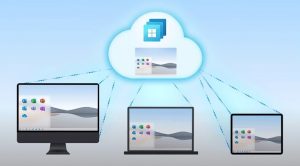Discover the Advance Capabilities of Azure Virtual Desktop
Azure Virtual Desktop is a cloud-based virtual desktop service that provides users with access to Windows 10 desktops and applications from any device. It is an enterprise-level solution for organizations looking to make their IT infrastructure more secure and cost-effective by reducing the need to purchase, maintain, and manage physical hardware.
With Azure Virtual Desktop, users can securely access their files, applications, and desktops from anywhere in the world with an internet connection. It provides a secure environment for data storage and collaboration, as well as ensures compliance with industry standards such as HIPAA and GDPR. Azure Virtual Desktop also integrates seamlessly with existing IT systems such as Active Directory or Microsoft Office 365.
Advantages of Azure Virtual Desktop
The increasing demand for cloud-based business solutions has led to a rise in the use of Azure Virtual Desktop. This cloud computing platform offers organizations an efficient and cost-effective way to access their applications and data from any location with an internet connection. As more businesses look to leverage the benefits of cloud computing, Azure Virtual Desktop is becoming increasingly popular, due to its wide range of advantages.
Azure Virtual Desktop provides a secure remote desktop environment that can be accessed anytime, anywhere and on any device. This allows organizations to streamline their operations by enabling employees to work from home or when traveling without compromising the security of sensitive data or applications. Additionally, it eliminates the need for expensive hardware investments as all resources are hosted on Microsoft’s servers in the cloud.
Furthermore, Azure Virtual Desktop enables organizations to quickly deploy applications across multiple devices with minimal effort or cost as updates are handled automatically by Microsoft’s servers in the background. This ensures that all users can access the latest versions of their favorite software regardless of where they are located or what type of device they are using at any given time.
Key Features of Azure Virtual Desktop
Azure Virtual Desktop (AVD) is Microsoft’s cloud-based virtual desktop service that allows users to access a Windows 10 experience from any device. AVD brings together the power and convenience of the cloud with the flexibility of virtual desktops, allowing users to access their applications and files from anywhere, anytime. AVD offers a range of features designed to make it easier for businesses to deploy and manage virtual desktop solutions in the cloud. Here are some of the key features that make Azure Virtual Desktop stand out from other virtual desktop solutions.
- Secure Remote Access: Azure Virtual Desktop provides secure remote access for authorized users via its Remote Access Gateway service, which ensures user authentication and authorization before granting access to enterprise resources on Azure VMs or other cloud services such as Office 365 or Dynamics 365. The gateway also provides end-to-end encryption between user devices and enterprise resources to protect data at rest or in transit from unauthorized access or theft.
- Cost Savings: By using Azure Virtual Desktop, businesses can save money by deploying their private clouds instead of purchasing expensive hardware for each employee’s device. Additionally, as AVD is hosted on Microsoft’s servers, businesses can avoid costly maintenance fees associated with traditional server solutions.
Setting Up and Managing Azure Virtual Desktops
Azure Virtual Desktops is a powerful cloud computing solution offered by Microsoft Azure that allows businesses to create and manage virtual desktops in the cloud. It provides a secure, cost-effective, and scalable platform for businesses to access their applications and data from anywhere with an internet connection. This article will provide you with an overview of setting up and managing Azure Virtual Desktops in your organization.
The first step to setting up Azure Virtual Desktops is to configure the environment. You will need to create a resource group, which will contain all of the resources needed for your virtual desktops. This includes storage accounts, virtual networks, server images, users’ profiles, security policies and user groups. Once this is done you can deploy the necessary components into your resource group such as Windows 10 or Windows Server 2016 operating systems on top of which your applications can run.
The next step is configuring user access rights so that users can log into their virtual desktops remotely over the internet securely using Remote Desktop Protocol (RDP). You can also configure additional security mechanisms such as two-factor authentication or multi-factor authentication for added security when accessing corporate data through remote connections.
Security Considerations for Using Azure Virtual Desktops
Azure Virtual Desktops offer businesses the ability to access their computing resources from any device, anywhere in the world. This cloud-based technology is quickly becoming a popular choice for companies looking to eliminate hardware and IT costs associated with traditional desktop systems. While this technology offers numerous benefits, organizations need to consider security measures when using Azure Virtual Desktops.
The first step in ensuring security is setting up a secure connection between the user’s device and the virtual desktop system. It’s important to use a VPN or other secure tunneling protocol that encrypts data while in transit between devices. Additionally, use strong authentication methods such as two-factor authentication (2FA) or biometric identification which adds an extra layer of security that helps prevent unauthorized access.
Organizations should also be sure to configure their Azure Virtual Desktop settings correctly to ensure maximum safety and performance of the system. This includes setting up firewalls, antivirus software, patch management policies, encryption protocols and other security measures as needed for each environment being used on the virtual desktop system. Additionally, administrators should review activity logs regularly to identify any suspicious events or activities that may indicate malicious activity or misuse of resources on their virtual desktops.
Cost of Deploying and Maintaining an Azure Virtual Desktop Environment
Azure Virtual Desktop (AVD) is a cloud-based virtual desktop infrastructure (VDI) solution created by Microsoft. AVD provides users with secure, on-demand access to applications and data from any device, anywhere in the world. This makes it an ideal option for businesses looking to increase their productivity while reducing costs associated with managing traditional desktops and laptops. However, deploying and maintaining an AVD environment can be quite expensive. In this article, we’ll take a look at the cost of deploying and maintaining an AVD environment.
To begin with, you’ll need to purchase licenses for all your users who will be accessing the AVD environment from their devices. Depending on the type of license you choose, these can range from $2-$100 per user per month depending on the features needed. You will also need to purchase Windows Client licenses for each user if they are not using Windows 10 Enterprise or Education editions as part of their subscription plan. Lastly, if you decide to set up additional features such as RemoteFX or GPU acceleration support then you may also have additional licensing fees associated with those features as well.
The next cost comes in terms of hardware requirements needed to deploy your AVD environment properly; this includes servers.
Conclusion
Azure Virtual Desktop is a great tool for businesses and individuals alike. It provides a secure, remote desktop environment that can be accessed from anywhere with an internet connection. With its flexibility and scalability, Azure Virtual Desktop makes it easier than ever to manage your virtualized IT environment. From cost savings to increased security, Azure Virtual Desktop has many advantages that make it an ideal choice for those looking to improve their remote computing capabilities.






